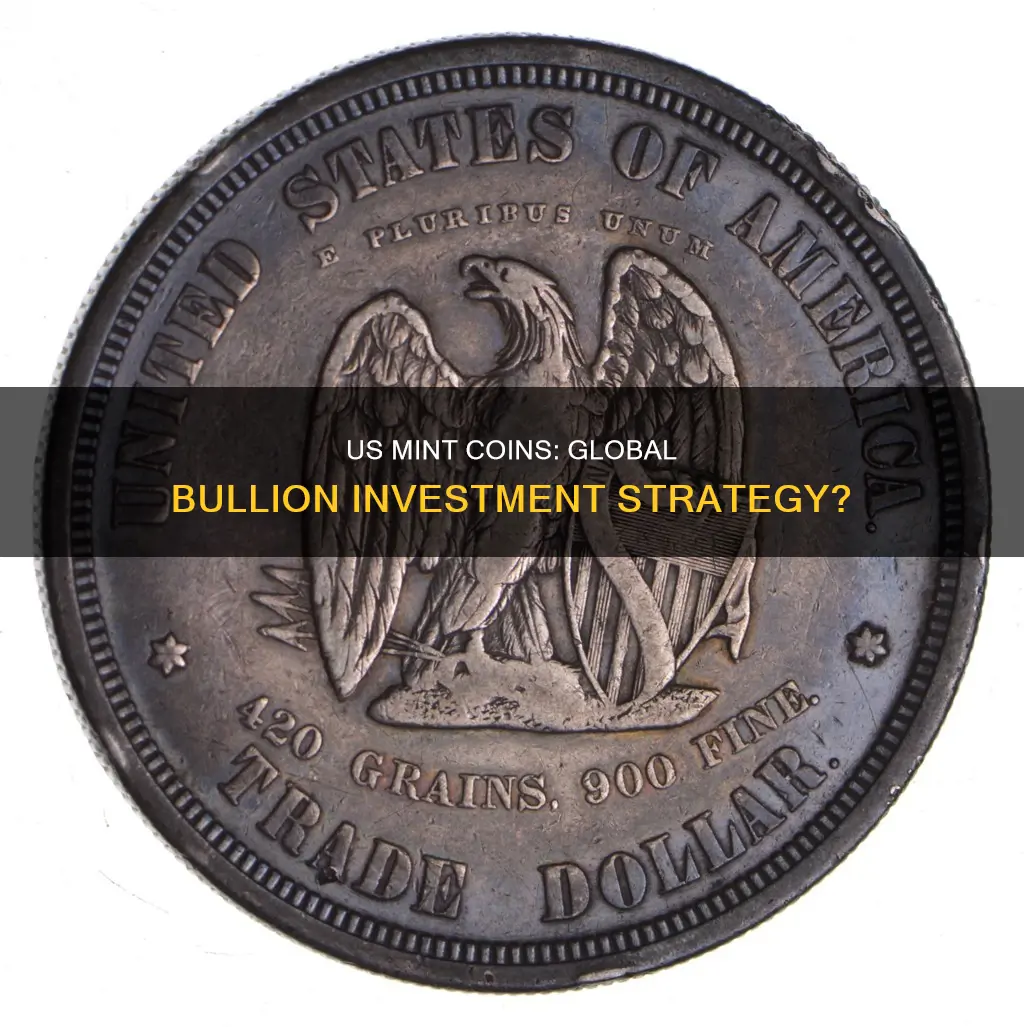
US Mint Coins have been around since 1792, providing a long history of coin production. The US Mint has produced everything from the USA's original gold and silver coinage to commemorative medals. When considering the investment potential of US Mint coins, investors weigh factors such as rarity, demand, historical significance, and metal content. The US Mint also produces bullion coins, which are investment-grade coins valued by their weight and the fineness of a specific precious metal. These coins are purchased by investors seeking a simple and tangible means to own and invest in the gold, silver, platinum, and palladium markets. The US Mint's bullion coins are sold based on the prevailing market price of gold, silver, platinum, or palladium, plus a small premium to cover minting, distribution, and marketing costs. The most profitable way to make profits from US Mint coins is by capitalizing on their rarity. Rare coins are more likely to fetch higher prices among collectors and investors.
| Characteristics | Values |
|---|---|
| Historical Background | US Mint has been around for two centuries, since 1792 |
| Rarity | Rare coins are more valuable and desirable |
| Demand | Demand for US Mint coins is influenced by economic trends and collector sentiment |
| Metal Content | Gold and silver coins have intrinsic worth, but collector interest can amplify market price |
| Reputation | US Mint has a great reputation for making high-quality coins |
| Aesthetics | The Eagle design (in Gold) is the most popular coin in the world |
| Price | US Mint coins are more expensive than similar foreign bullion coins |
| Premium | Limited edition bullion often comes at a premium without offering equivalent resale value |
| Numismatic Value | Rare coins have higher numismatic value and accrue value faster than generic coins |
| Collectability | US Mint coins have collectability value due to their historical significance |
What You'll Learn

US Mint coins: historical background
The history of US Mint coins began long before the opening of a national mint in 1792. Before that, a mix of foreign and domestic coins circulated during the Colonial Period and in the years following the Revolutionary War.
During the Colonial Period, monetary transactions were handled using foreign or colonial currency, livestock, or produce. British pounds, German thalers, Spanish milled dollars, and even some coins produced by the colonies were used. Spanish milled dollars became particularly popular due to the consistency of their silver content.
After the Revolutionary War, the Articles of Confederation allowed each state to make their own coins and set their values. This led to a confusing situation where the same coin could have different values from state to state.
In 1787, Congress authorized the production of copper cents, called Fugio cents, which featured a sundial on the obverse and a chain of 13 links on the reverse. However, the ratification of the Constitution in 1788 by a majority of states established a new government and sparked a new debate over national coinage.
On April 2, 1792, Congress passed the Coinage Act, establishing the first national mint in the United States. The act specified the following coinage denominations: half cent and cent in copper; half dime, dime, quarter, half dollar, and dollar in silver; and quarter eagle ($2.50), half eagle ($5), and eagle ($10) in gold.
Philadelphia, then the nation's capital, was chosen as the site of the first Mint. President George Washington appointed renowned scientist David Rittenhouse as the first director. The Mint's first circulating coins, 11,178 copper cents, were delivered in March 1793.
As gold fever spread across the US, branch Mints and assay offices opened to meet the demands of a growing nation. The Mint has operated several branch facilities throughout its history, with the first branch mints opening in Charlotte, North Carolina; Dahlonega, Georgia; and New Orleans, Louisiana, in the 1830s.
Today, the Mint maintains production facilities in Philadelphia, San Francisco, Denver, and West Point, and a bullion depository in Fort Knox, Kentucky.
Dogecoin: A Legitimate Investment or Just a Meme?
You may want to see also

US Mint coins as bullion
US Mint coins are a good investment as bullion due to their reliable purity levels. The US Mint has been producing coins since 1792, giving it ample time to perfect its craft. The mint's reputation and aesthetic designs, such as the Eagle design, also make its bullion coins a better investment.
The US Mint's bullion coins are also a good investment because they are investment-grade coins valued by their weight and fineness of a specific precious metal. They provide investors with a convenient and cost-effective way to add physical gold, silver, platinum, or palladium to their investment portfolios. The American Eagle Bullion Coin Program, launched in 1986, includes gold, silver, platinum, and palladium coins. The American Buffalo Bullion Coin Program, introduced in 2008, further adds to the US Mint's bullion coin offerings.
When considering the investment potential of US Mint bullion coins, factors such as rarity, demand, historical significance, and metal content come into play. Numismatic enthusiasts value certain minted coins due to their limited supply or unique features. The desirability of these coins is influenced by economic trends and collector sentiment.
The US Mint's bullion coins are sold based on the prevailing market price of the precious metal plus a small premium to cover minting, distribution, and marketing costs. As such, the US Mint's bullion coins are a good investment for those seeking a simple and tangible means to own and invest in precious metals.
However, it is important to note that limited-edition bullion from the US Mint may not offer equivalent resale value. Therefore, it is crucial for purchasers to carefully weigh the benefits of such offerings against typical collections found among general investors.
The Ultimate Guide to Investing Bitcoin with Fidelity
You may want to see also

US Mint coins: rarity and demand
The United States Mint has been producing coins for over two centuries, providing ample time to create a vast array of coinage. The Mint's longevity and diverse output contribute to the rarity and demand for specific US Mint coins among collectors and investors.
Rarity
The first rule of investing in coins is that rarity drives their value and appeal in the collectible market. US Mint coins have been produced since 1792, with a long history of creating coins of varying rarity. Some US Mint coins are more common, ending up in investors' pockets rather than collections. However, certain coins stand out due to their limited production or unique characteristics.
Demand
The demand for US Mint coins stems from their historical significance, aesthetic appeal, and trusted quality. The Mint's reputation for producing high-quality coins with iconic designs, such as the Eagle and the Buffalo, has captivated investors and collectors worldwide. The patriotic themes and American symbolism featured on these coins further enhance their desirability.
Additionally, the US Mint's gold coins are recognised for their investment potential and numismatic value. Gold has long been a stable store of value, and US Mint gold coins, backed by the US government, offer a tangible and portable form of wealth. This credibility, combined with the limited supply of certain coins, drives demand among those seeking to diversify their portfolios.
The US Mint also produces commemorative coinage that transcends the value of their intrinsic metals. These coins often sell for significantly more than standard bullion coins due to their unique designs and limited editions. The commemorative aspect adds to their appeal, reminding customers of historical events and significant milestones.
Factors Influencing Rarity and Demand
Several factors influence the rarity and demand for US Mint coins:
- Surface preservation: The condition of a coin's surface, including wear and tear, is a critical factor in determining its grade and value. Coins with less wear and a higher grade tend to be more desirable to investors.
- Lustre: The lustre, or shine, of a coin can affect its rarity and demand. A coin with a brilliant, uncirculated lustre may be more sought-after than a circulated coin with a dull appearance.
- Strike quality: The quality of the strike, or the sharpness of the design details, can impact a coin's rarity. A well-struck coin with clear, crisp details is generally more desirable than a weakly struck coin.
- Errors: Rare errors or variations in the design or minting process can significantly increase a coin's rarity and demand among collectors. These errors may include misprints, off-centre strikes, or unique design elements.
- Limited editions: Limited edition or commemorative coins are often sought-after due to their rarity and special significance. The limited availability of these coins can drive up their demand and value.
- Metal type: The type of metal used in the coin can influence its rarity and demand. Precious metals like gold, silver, and platinum are typically more desirable to investors and collectors.
- Historical context: The historical context of a coin's production can affect its rarity and demand. Coins associated with significant historical events or periods may be more sought-after due to their connection to a particular era in American history.
Should You Invest in Facebook's New Crypto Coin?
You may want to see also

US Mint coins: numismatics and investment potential
The United States Mint has been producing coins since 1792, when the Coinage Act of 1792 established Philadelphia's national mint. This long history has resulted in a wide variety of coins, some of which have become highly sought-after by collectors and investors.
Numismatic Value
US Mint coins have numismatic value due to their limited supply, unique features, historical significance, and rarity. Numismatic enthusiasts often see value in certain minted coins beyond their precious metal content, such as gold and silver. Collector interest can significantly amplify a coin's market price, with some rare coins selling for millions of dollars. For example, a 1907 Double-Eagle coin is highly valued due to its scarcity and historical allure.
Investment Potential
When considering the investment potential of US Mint coins, factors such as rarity, demand, historical significance, and metal content are crucial. The desirability of these coins can be influenced by economic trends and collector sentiment. US Mint coins with limited circulation, such as uncirculated coin sets, tend to have higher investment potential as they are scarcer. Additionally, coins with historical significance, such as those commemorating specific events or locations, often resonate more deeply with buyers, increasing their potential profitability.
Bullion Coins
US Mint bullion coins are valued primarily for their precious metal content, such as gold, silver, platinum, or palladium. These coins are purchased by investors seeking a tangible way to invest in the precious metals market. The value of bullion coins is based on their weight and the fineness of the specific precious metal they contain. While bullion coins may not have the same collector appeal as numismatic coins, they offer a straightforward investment option with clear pricing based on metal content.
Grading and Preservation
When investing in US Mint coins, it is essential to consider factors such as preservation quality and grading errors. Top-grade coins with minimal wear and tear, indicated by a higher grade on a scale from 1 to 70, tend to be the most valuable. Professional grading is crucial in ensuring the authenticity and condition of the coins, which can impact their investment potential and resale value.
In conclusion, US Mint coins have investment potential due to their numismatic value, rarity, and historical significance. While some coins may be more desirable to collectors than others, the decision to invest in US Mint coins ultimately depends on individual preferences and investment goals.
Coin Bootcamp: Your Gateway to Investment Banking?
You may want to see also

US Mint coins: silver and gold value trends
The United States Mint has been producing coins since 1792, providing a long history of coinage for investors and collectors. When considering the investment potential of US Mint coins, factors such as rarity, demand, historical significance, and metal content are essential. In this article, we will focus on the value trends of silver and gold US Mint coins and their potential as investments.
Silver Value Trends
Silver US Mint coins have been in circulation since 1964, and their value trends have fluctuated over time. Silver coins, such as silver dollars, often transcend their legal tender status and can fetch more than their face value when traded among enthusiasts. The demand for silver US Mint coins is driven by their historical significance and potential numismatic value.
Silver bullion, on the other hand, is preferred for larger volume investments seeking stability without regard for collectability. The pricing of silver bullion is straightforward and based solely on silver content. It is important to recognize that investment returns on silver can vary widely between pure metal weight and additional numismatic worth. Therefore, understanding market trends and diligence in researching both innate metallic values and any historical or rare coin premiums are crucial before investing in silver US Mint coins.
Gold Value Trends
Gold US Mint coins also have a long history, with gold coin denominations established in 1792, including quarter eagles ($2.50), half eagles ($5), and full eagles ($10). Gold holds its allure as an investment, catering to different types of investors. For collectors, gold coins appeal due to their historical significance and potential numismatic value. The aesthetic design of gold bullion coins, such as the popular Eagle design, further enhances their desirability and investment potential.
For larger volume investments, gold bullion provides stability and is less concerned with collectability. However, it is important to note that gold coins are fewer in number compared to silver coins, making it easier to generate profits on gold coins. The introduction of US Mint bullion coins as an investment option has made them a good choice today due to their high value.
In conclusion, US Mint coins in silver and gold have their unique value trends and investment potential. Silver coins offer historical significance and numismatic value, while silver bullion provides straightforward pricing based on metal content. Gold coins, with their aesthetic designs and historical allure, cater to collectors and investors seeking stability. US Mint bullion coins, in both silver and gold, are a good investment option due to their high value and the reputation of the US Mint. However, it is essential to carefully consider factors such as rarity, preservation quality, and market trends before making any investment decisions.
The Bitcoin Investment: Your Portfolio's Worth?
You may want to see also
Frequently asked questions
A bullion coin is an investment-grade coin that is valued by its weight and fineness of a specific precious metal. They are purchased by investors seeking a simple and tangible means to own and invest in the gold, silver, platinum, and palladium markets.
US Mint coins are minted by the United States Mint, which has been in operation since 1792. The mint produces everything from the USA's original gold and silver coinage to commemorative medals.
The answer varies depending on who you ask. Some sources claim that US Mint coins are a good investment due to their historical and aesthetic value. Others argue that investors should stick to silver bars or the lowest-premium product available.
US Mint coins can be purchased from the US Mint website (usmint.gov) or through local dealers and online markets.







